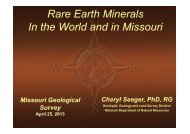Create successful ePaper yourself
Turn your PDF publications into a flip-book with our unique Google optimized e-Paper software.
Gosen, Foley, and Cordier, 2010). The Commonwealth<br />
of Independent States (Azerbaijan, Armenia,<br />
Belarus, Georgia, Kazakhstan, Kyrgyzstan, Moldova,<br />
Russia, Tajikistan, Turkmenistan, Uzbekistan,<br />
and Ukra<strong>in</strong>e) controls about 19 percent, followed<br />
by Australia with 5.4 percent and India with 3.1<br />
percent (Long, Van Gosen, Foley, and Cordier,<br />
2010).<br />
Ch<strong>in</strong>a’s state-owned m<strong>in</strong>es kept <strong>rare</strong> <strong>earth</strong> prices<br />
artificially low dur<strong>in</strong>g most of the past 15 years,<br />
which drove other suppliers out of bus<strong>in</strong>ess. The<br />
United States had the expertise, but lacked the<br />
manufactur<strong>in</strong>g <strong>in</strong>frastructure to ref<strong>in</strong>e <strong>rare</strong> <strong>earth</strong><br />
oxides to metals. Rebuild<strong>in</strong>g the U.S. REE supply<br />
cha<strong>in</strong> has begun, but could take as long as 15 years<br />
to complete (Long, Van Gosen, Foley, and Cordier,<br />
2010; Hsu, 2010). Achiev<strong>in</strong>g a secure strategic supply<br />
of REE seems to be more important now than<br />
the economic impact of develop<strong>in</strong>g the necessary<br />
supply cha<strong>in</strong>.<br />
The only current REE producer <strong>in</strong> the United<br />
States is the Molycorp m<strong>in</strong>e, produc<strong>in</strong>g from a carbonatite,<br />
at Mounta<strong>in</strong> Pass, California. Molycorp’s<br />
production has been from previously m<strong>in</strong>ed and<br />
stockpiled material. However, completion of their<br />
ongo<strong>in</strong>g expansion and modernization project is<br />
expected to produce about 19,050 tonnes (21,000<br />
tons) of REO equivalent per year, beg<strong>in</strong>n<strong>in</strong>g <strong>in</strong><br />
mid-2013 (Molycorp, 2013). The company plans<br />
to <strong>in</strong>crease production to 40,000 tonnes (44,090<br />
tons) of REO per year when justified by demand,<br />
product pric<strong>in</strong>g, capital availability, and f<strong>in</strong>ancial<br />
returns.<br />
REE m<strong>in</strong>erals and deposits are often classified as<br />
either LREE or HREE. However, s<strong>in</strong>ce both types<br />
usually occur together, the designation is often a<br />
statement relat<strong>in</strong>g to the economic dom<strong>in</strong>ance<br />
of either the light or the heavy <strong>elements</strong>. LREE<br />
deposits are the most common and HREE are<br />
generally more valuable than LREE. Molycorp’s<br />
Mounta<strong>in</strong> Pass deposit is dom<strong>in</strong>ated by LREE<br />
(Long, Van Gosen, Foley, and Cordier, 2010).<br />
A 2010 study by the U.S. Department of Energy<br />
(DOE) addressed the supply of critical m<strong>in</strong>erals <strong>in</strong><br />
9<br />
the United States. They used the term critical as a<br />
measure of importance to the economy, availability<br />
of clean energy, and risk of supply disruption.<br />
Among other m<strong>in</strong>erals and <strong>elements</strong> addressed,<br />
they considered five REE (Dy, Nd, Tb, Eu, and<br />
Y) as most critical <strong>in</strong> the short term future of the<br />
United States.<br />
Currently, REE projects be<strong>in</strong>g <strong>in</strong>vestigated for<br />
exploration or development <strong>in</strong> the United States<br />
<strong>in</strong>clude: the Bear Lodge deposit <strong>in</strong> Wyom<strong>in</strong>g;<br />
Bokan, Alaska; La Paz, Arizona; Diamond Creek,<br />
Idaho; Lemhi Pass, Idaho and Montana; Pea Ridge,<br />
Missouri; Elk Creek, Nebraska; Thor, Nevada; and<br />
Round Top, Texas (U.S. Geological Survey, 2013).<br />
rEE Prices<br />
REE prices have risen substantially <strong>in</strong> the last decade.<br />
Between October 2009 and June 2011, prices<br />
for all REE rose 1,500 percent, then retreated<br />
significantly dur<strong>in</strong>g the latter part of 2011 (Saywell,<br />
2011). Prices retreated further dur<strong>in</strong>g 2012,<br />
but rema<strong>in</strong>ed substantially higher than <strong>in</strong> 2010<br />
(U.S. Geological Survey, 2013). Although there<br />
have been major fluctuations, prices are expected<br />
to rema<strong>in</strong> high until a cha<strong>in</strong> of supply, process<strong>in</strong>g,<br />
and manufactur<strong>in</strong>g has been established outside of<br />
Ch<strong>in</strong>a. Table 4 shows the ris<strong>in</strong>g prices along with<br />
fluctuations <strong>in</strong> 2008, 2010, and 2011.<br />
Relative market values for REE are highly variable<br />
and depend <strong>in</strong> part on the source quoted.<br />
Prices also depend on the level of purity, which is<br />
determ<strong>in</strong>ed by the specifications for any particular<br />
application (Lynas Corporation, 2011). Pric<strong>in</strong>g<br />
occasionally addresses <strong>in</strong>dividual metallic <strong>elements</strong>.<br />
However, most references cite REE <strong>in</strong> oxide form,<br />
reported as REO. REO concentrates vary <strong>in</strong> their<br />
elemental mixes based on those found <strong>in</strong> their<br />
source deposits. REO prices vary accord<strong>in</strong>gly and<br />
may not be comparable between one deposit and<br />
another. Concentrates range from near 40 percent<br />
REO to 99 percent REO. One of the best sources<br />
for current REE price <strong>in</strong>formation is Metal-Pages<br />
(www.metal-pages.com/metalprices/<strong>rare</strong><strong>earth</strong>s),<br />
which requires a subscription to view.



